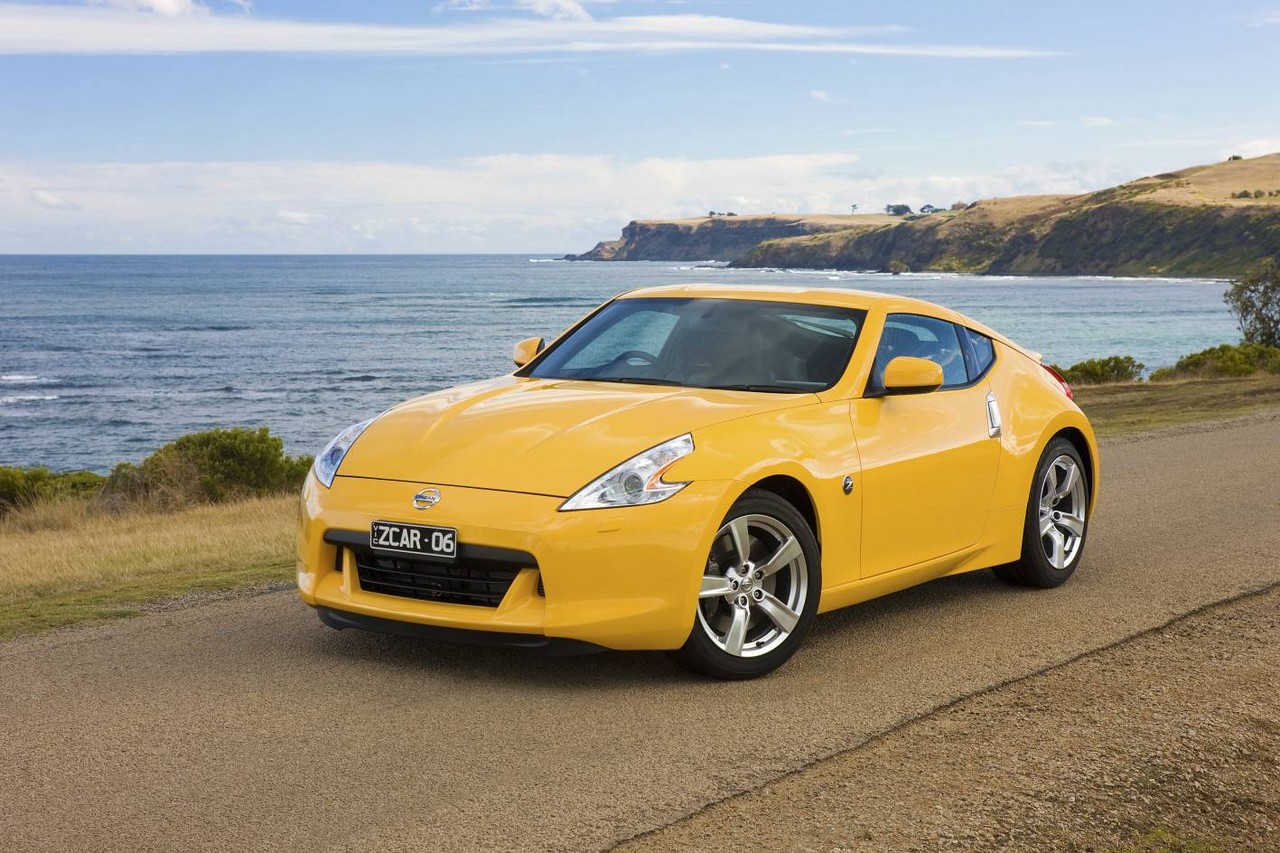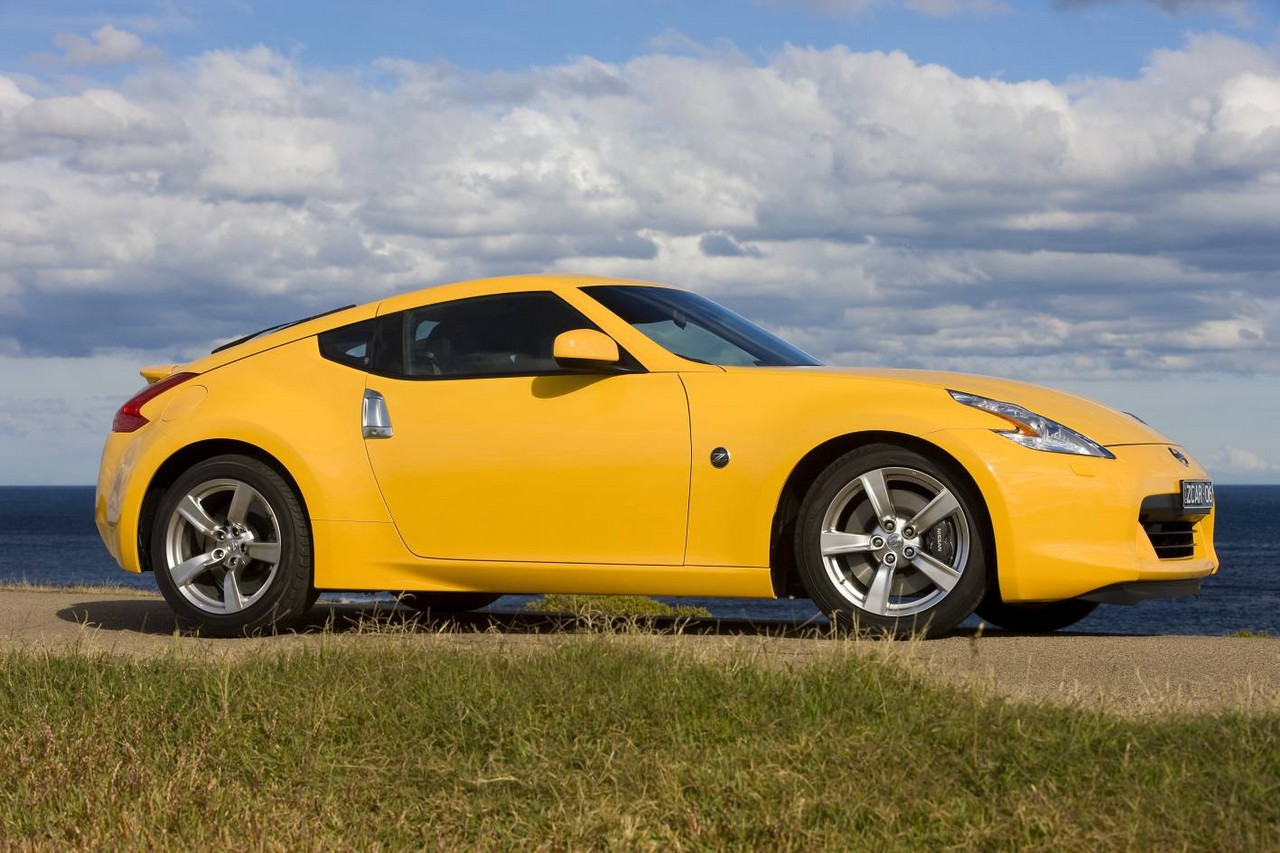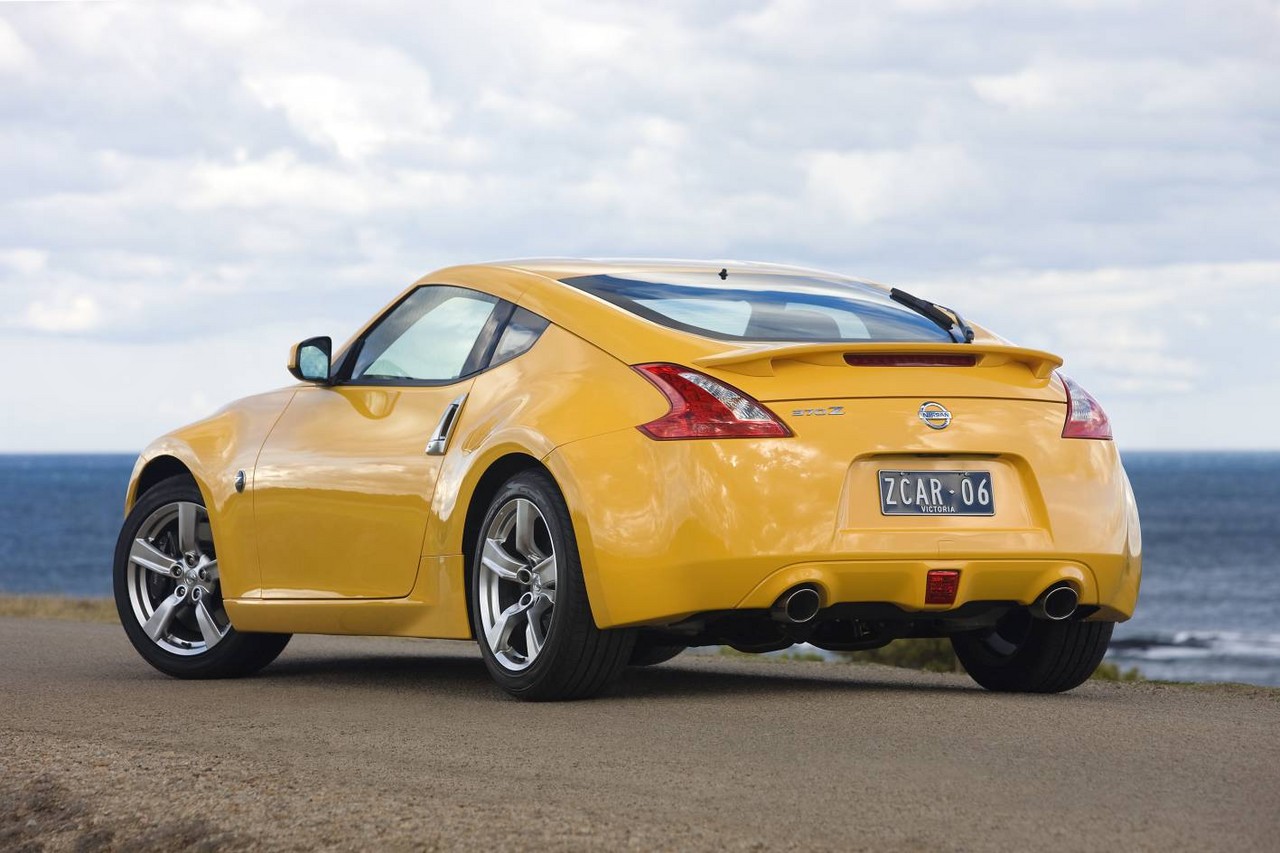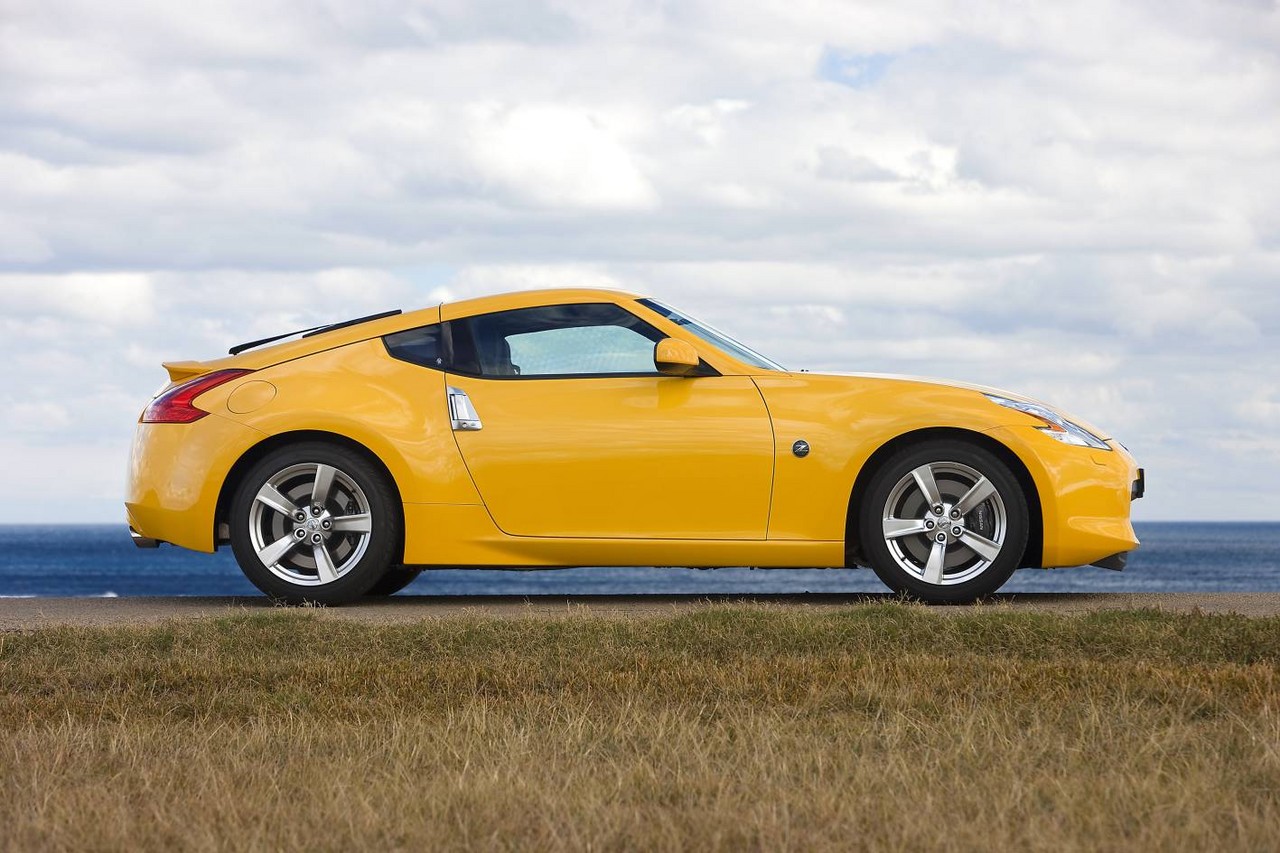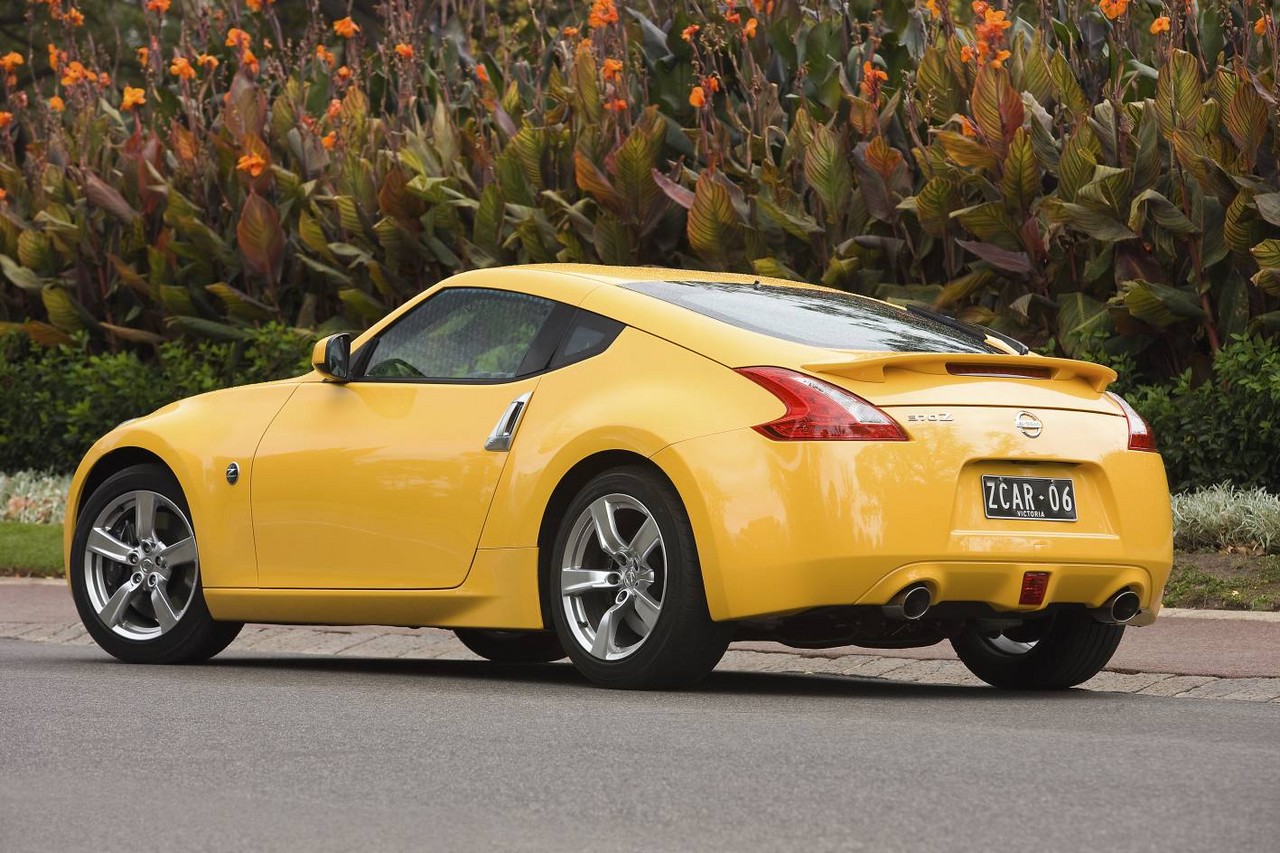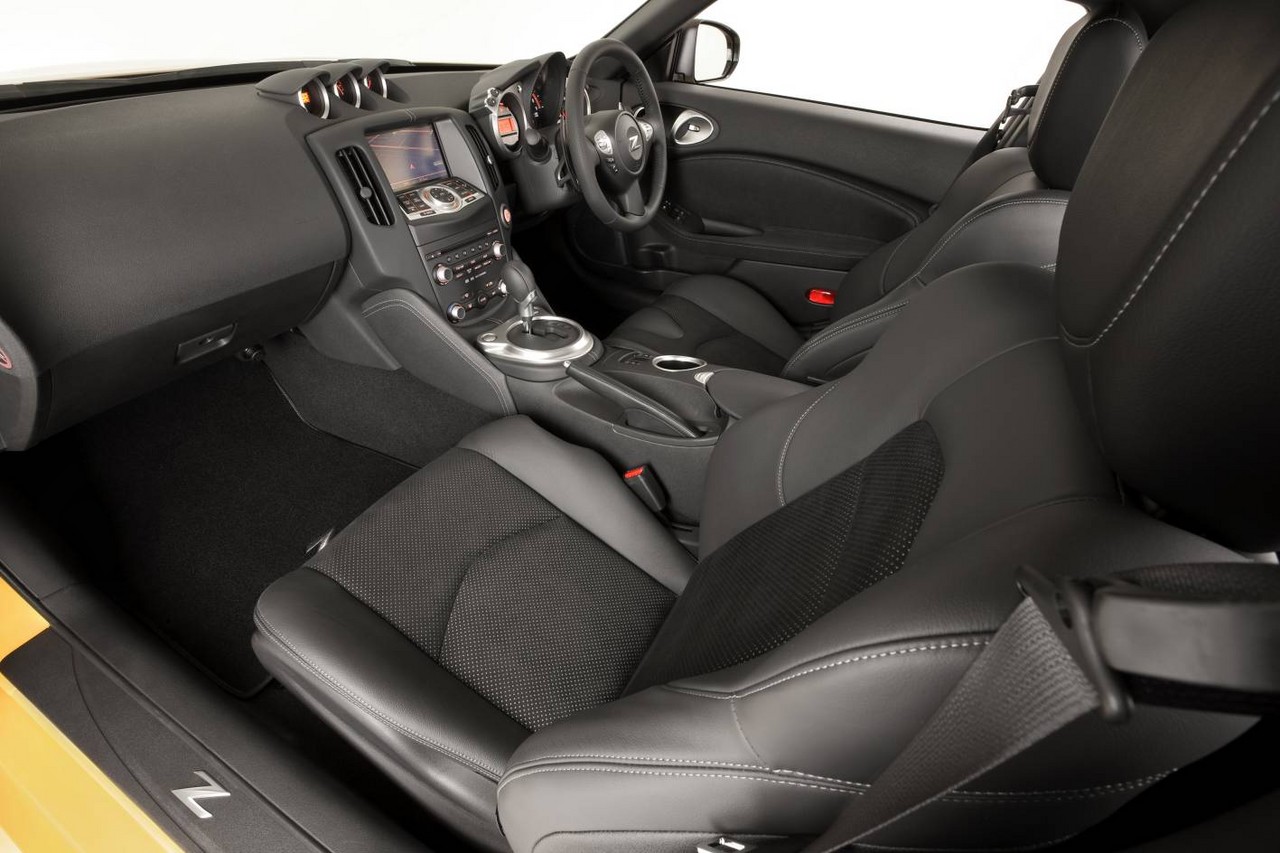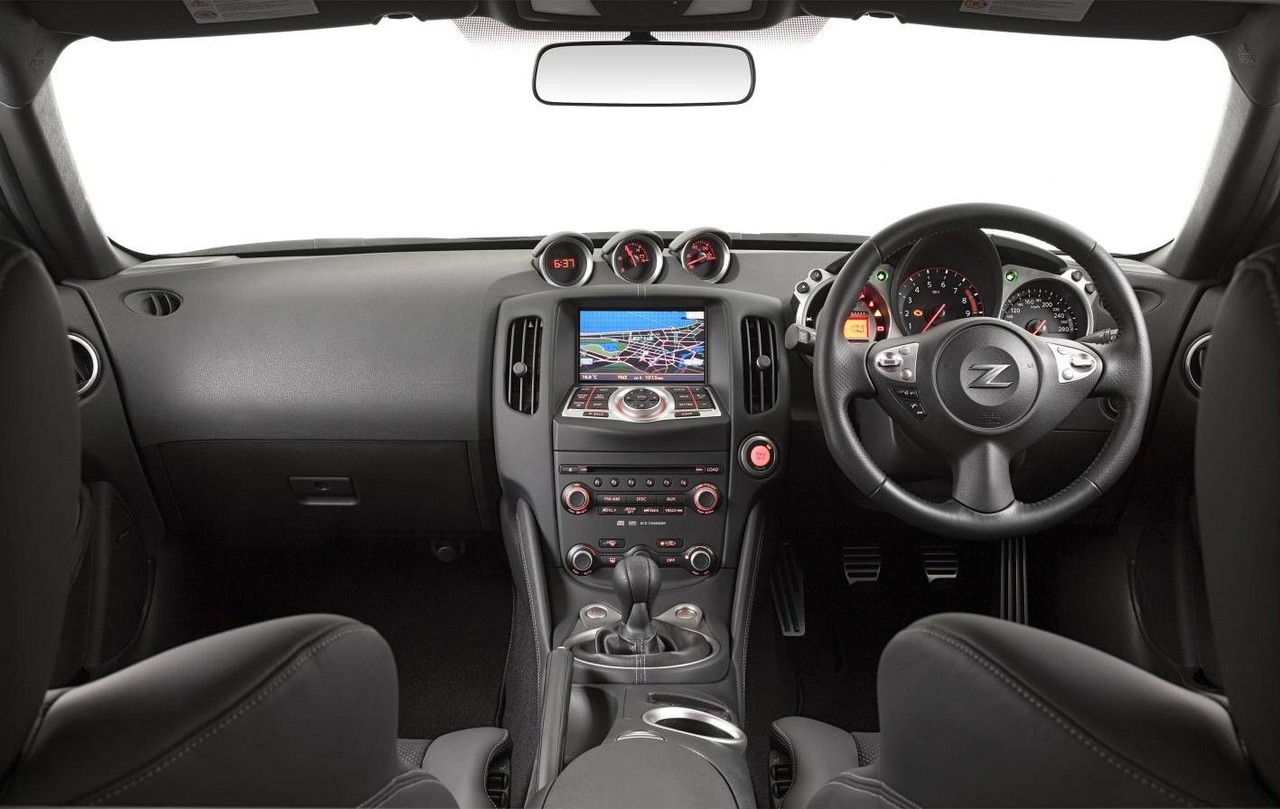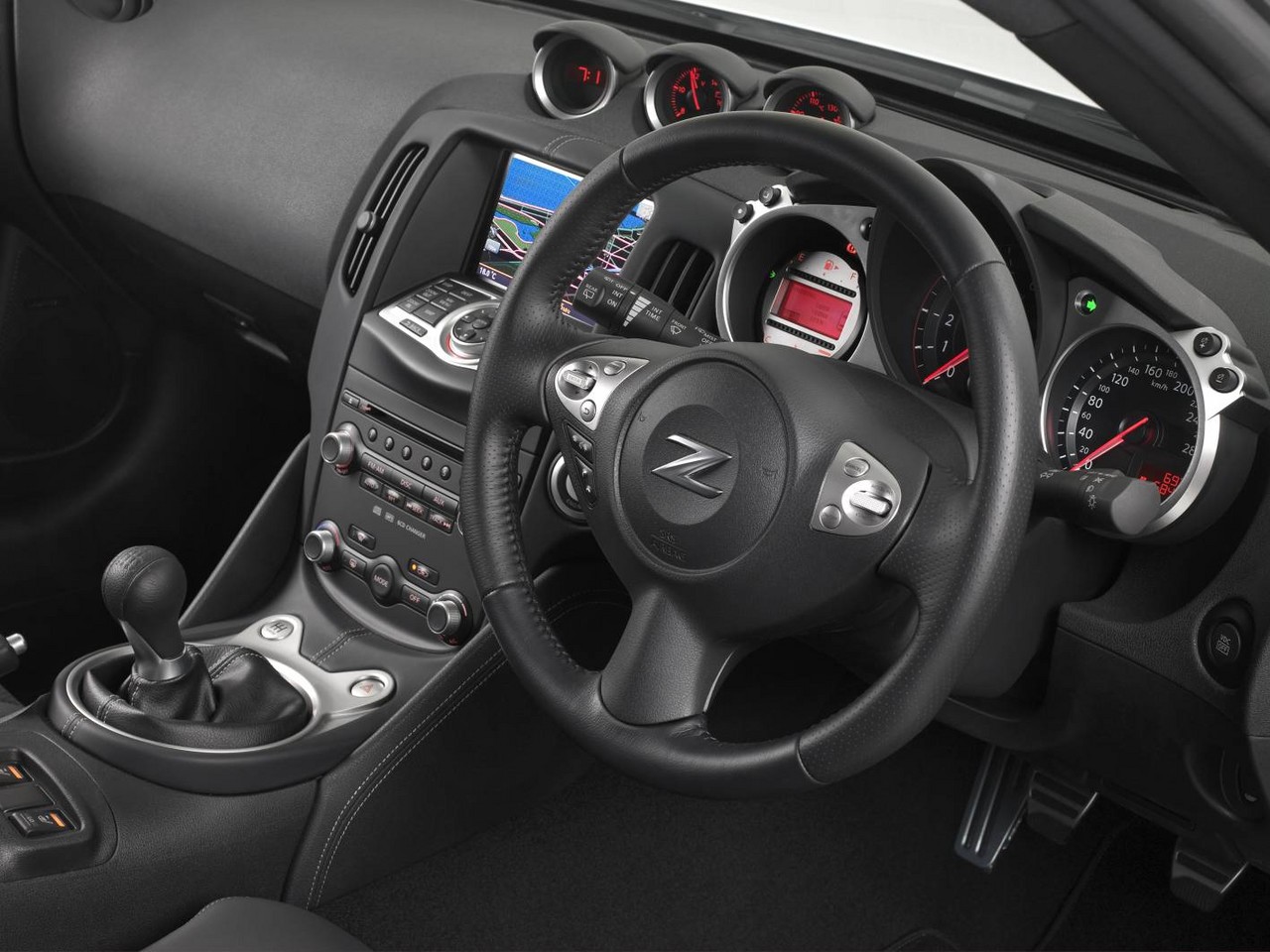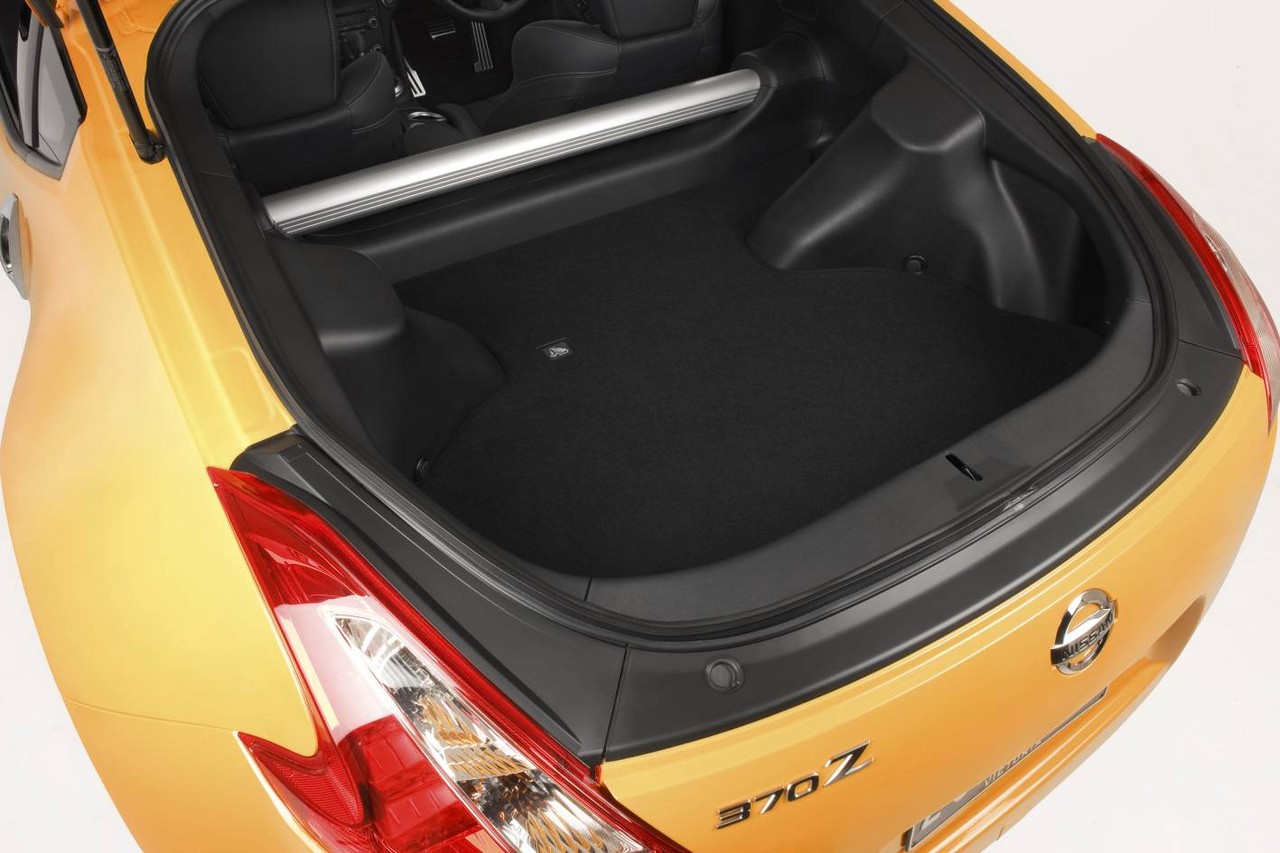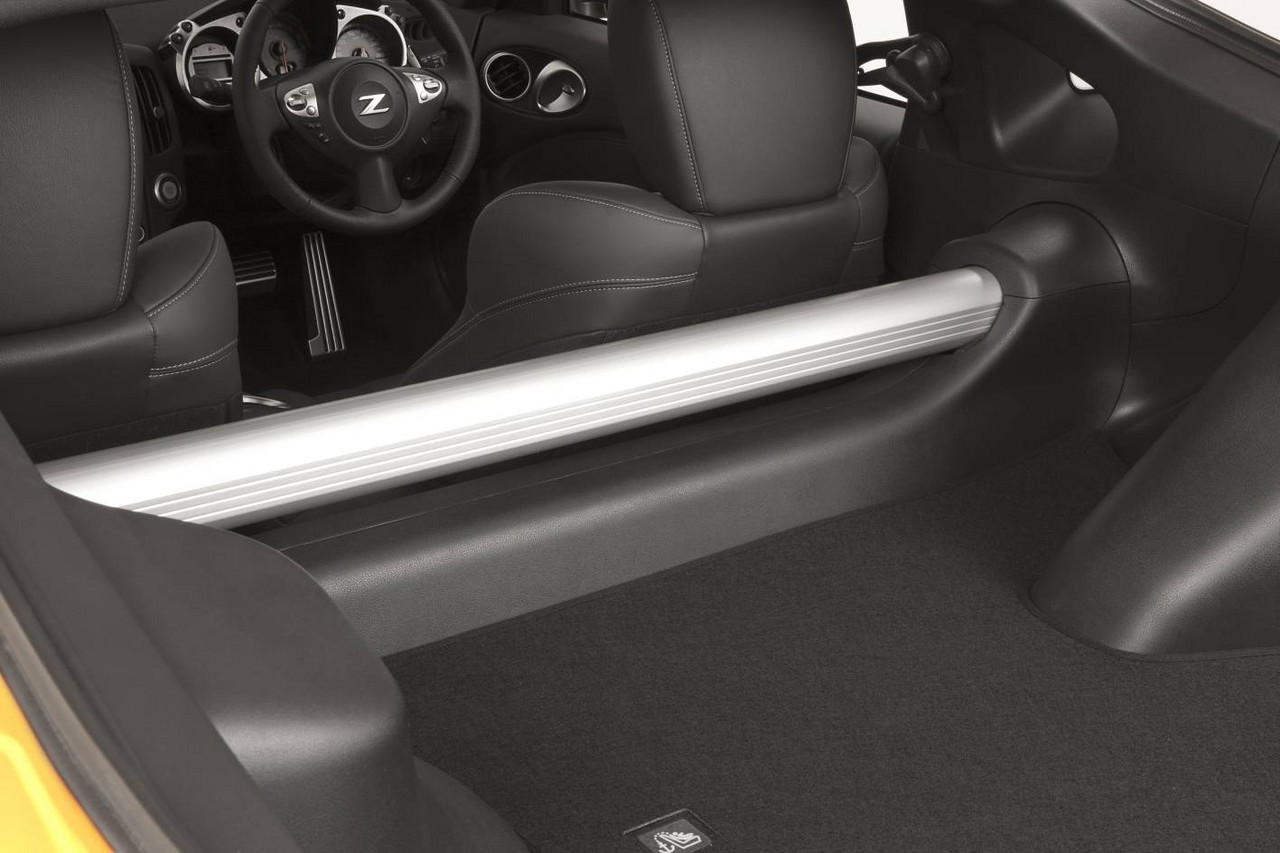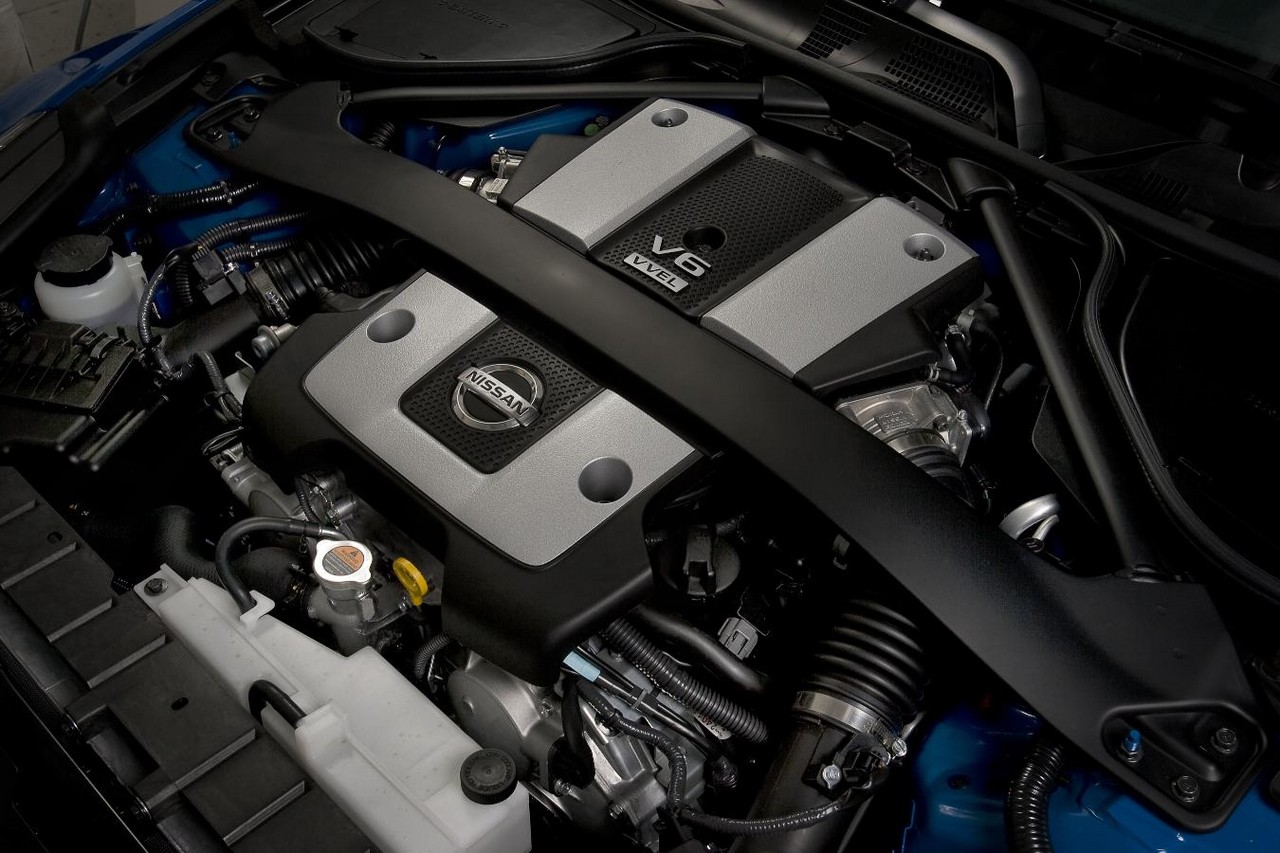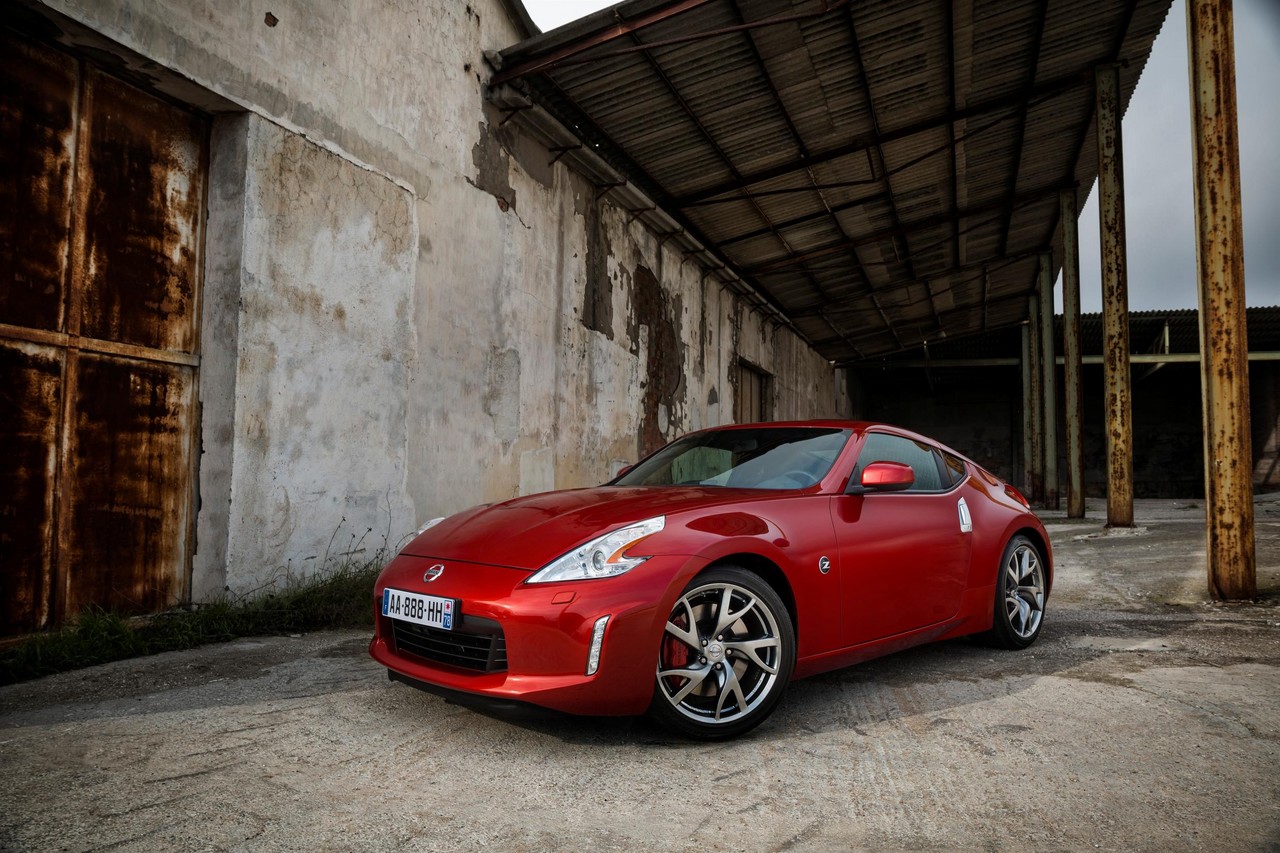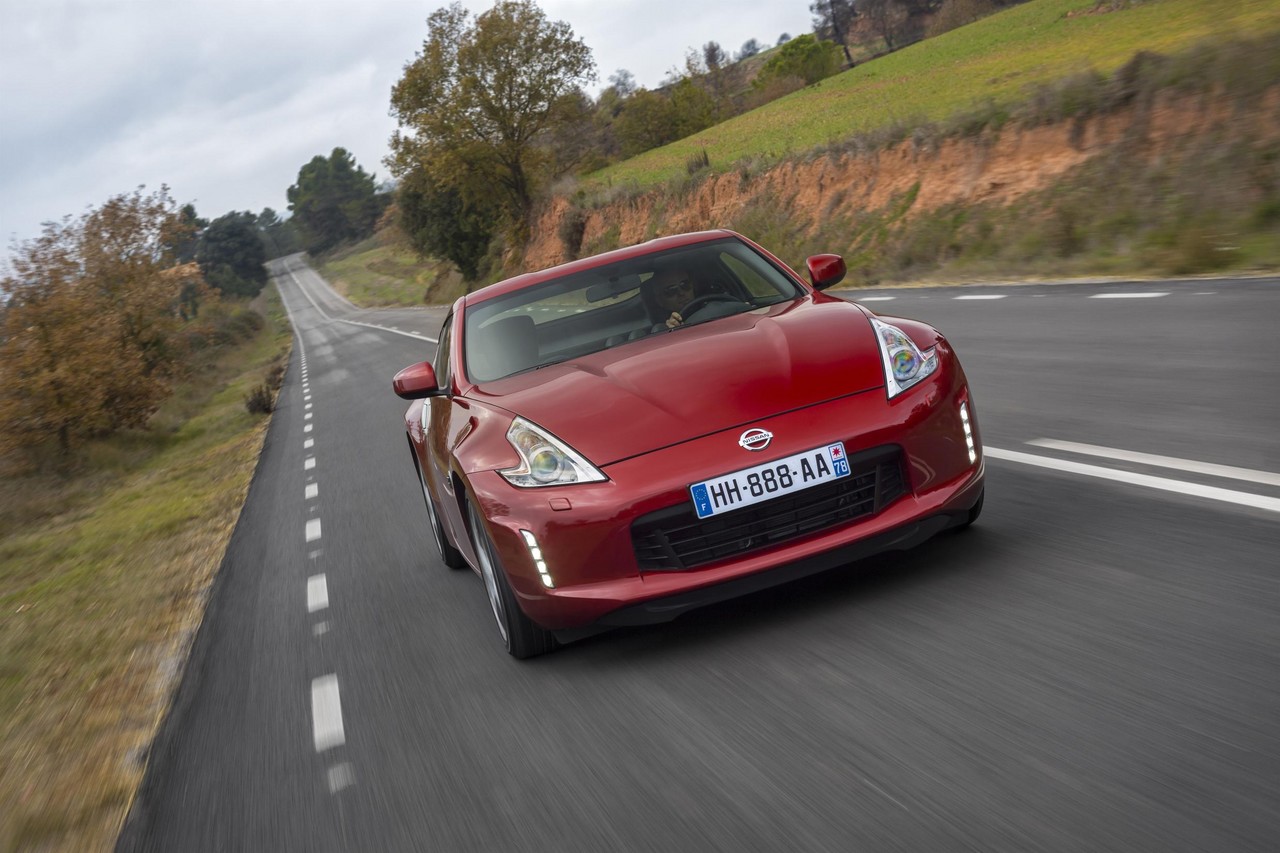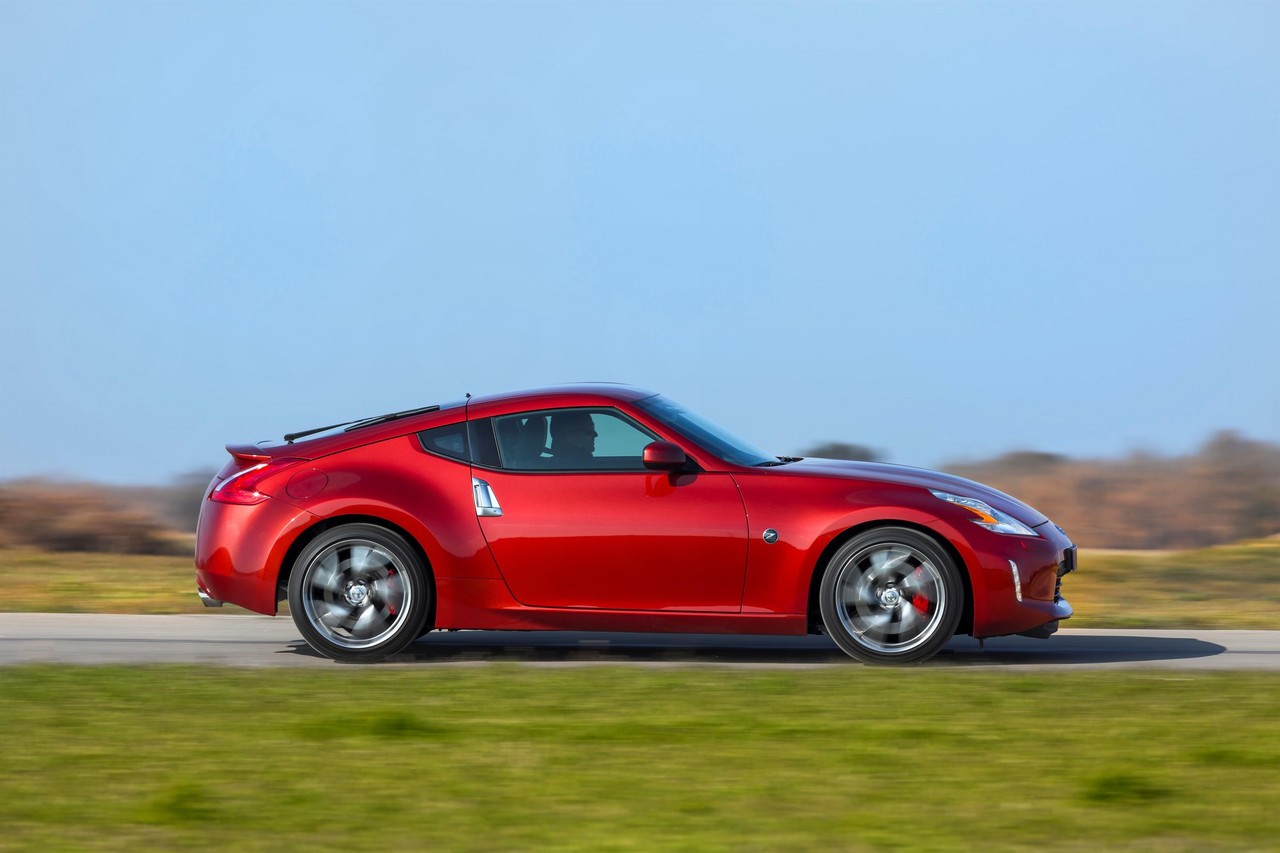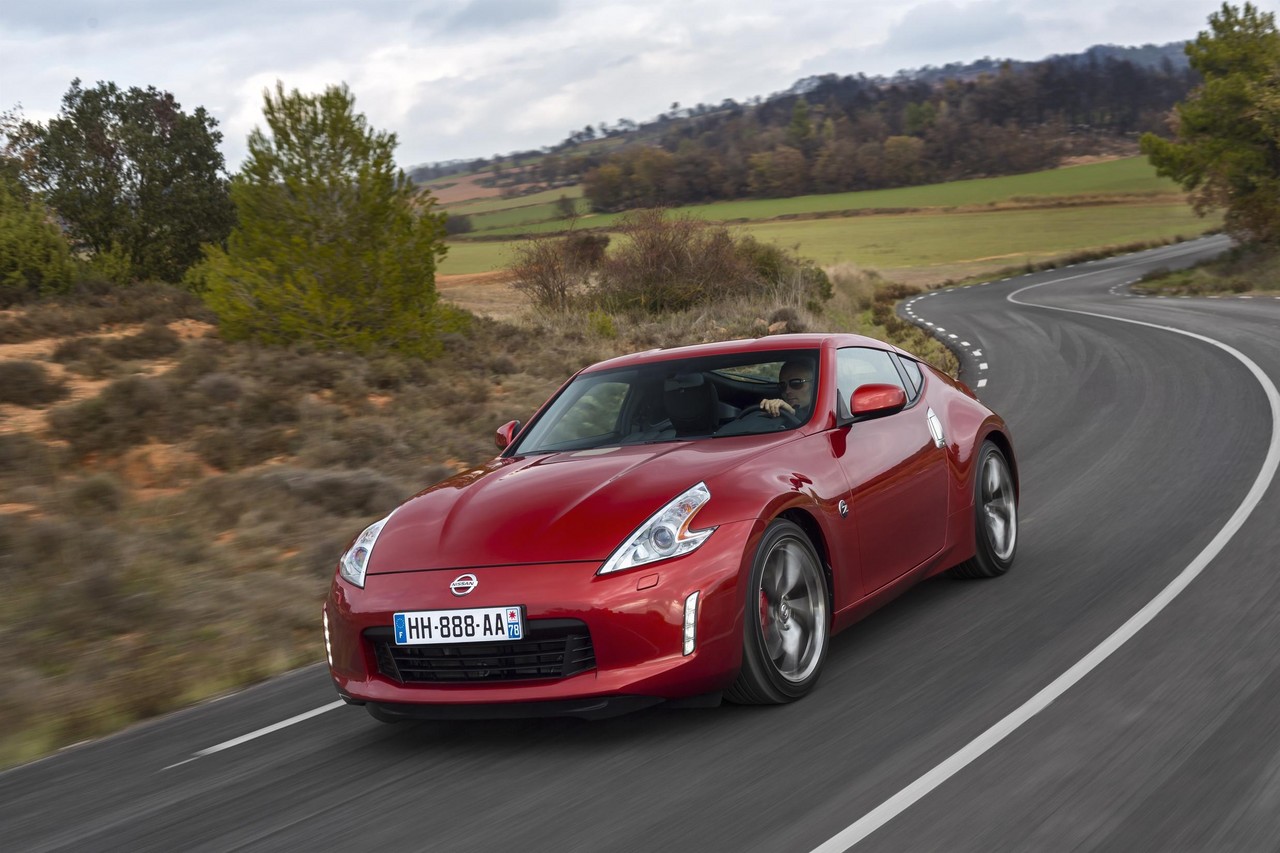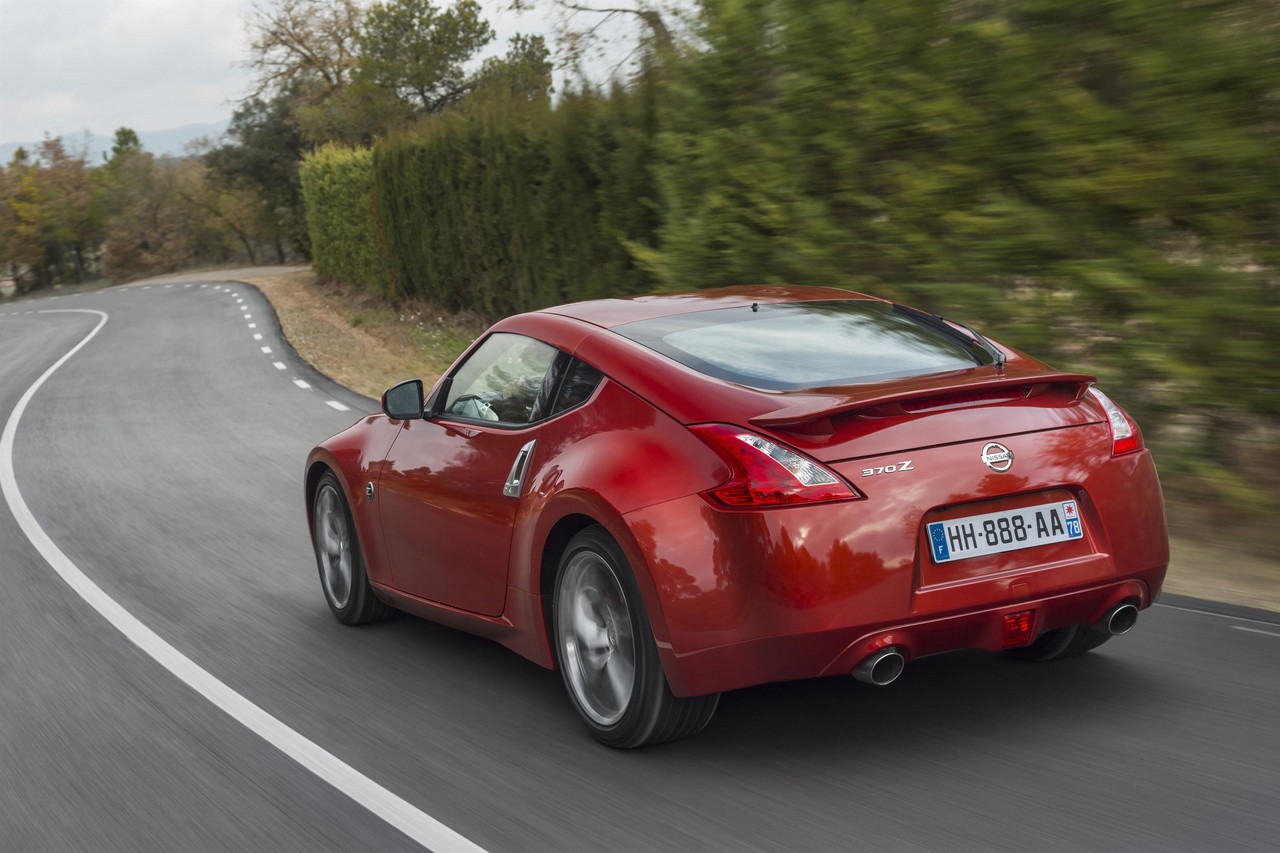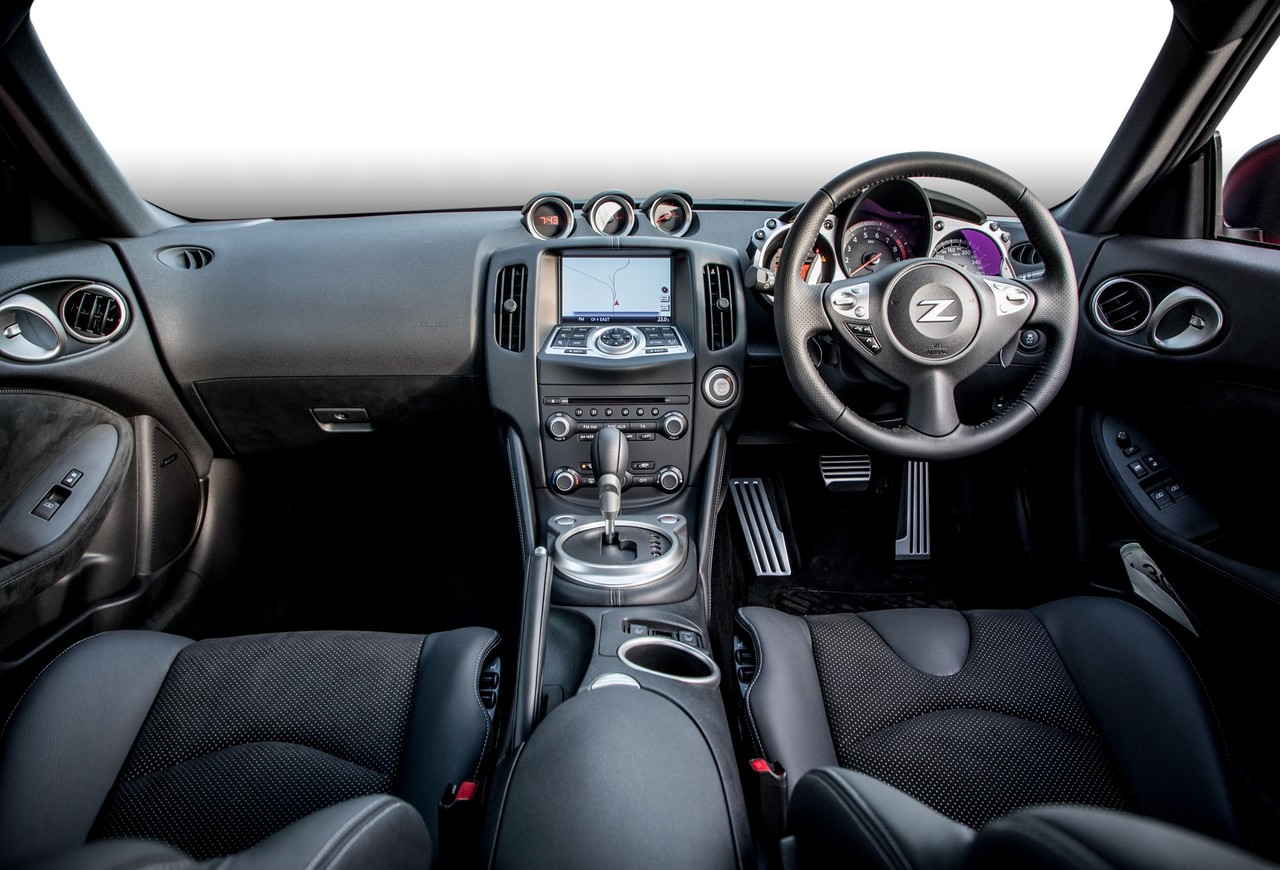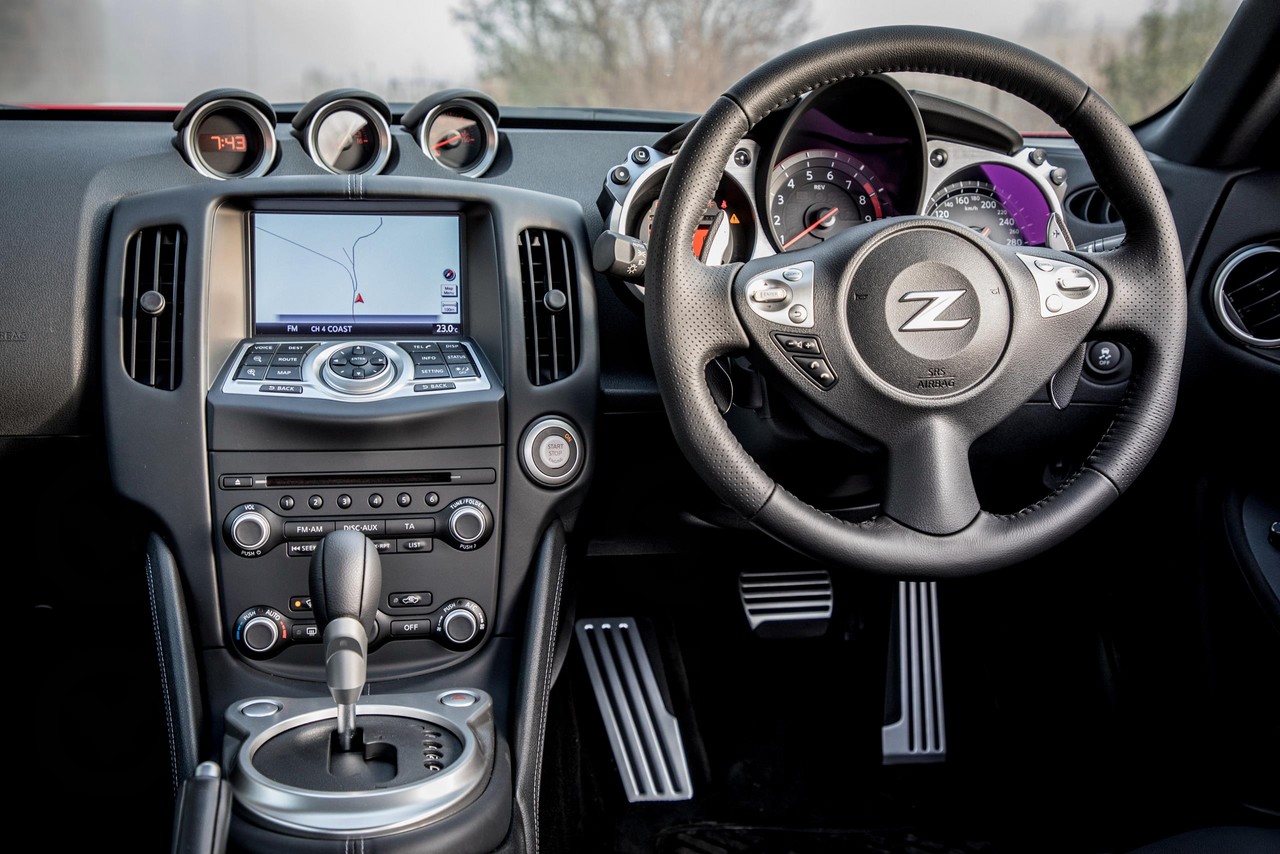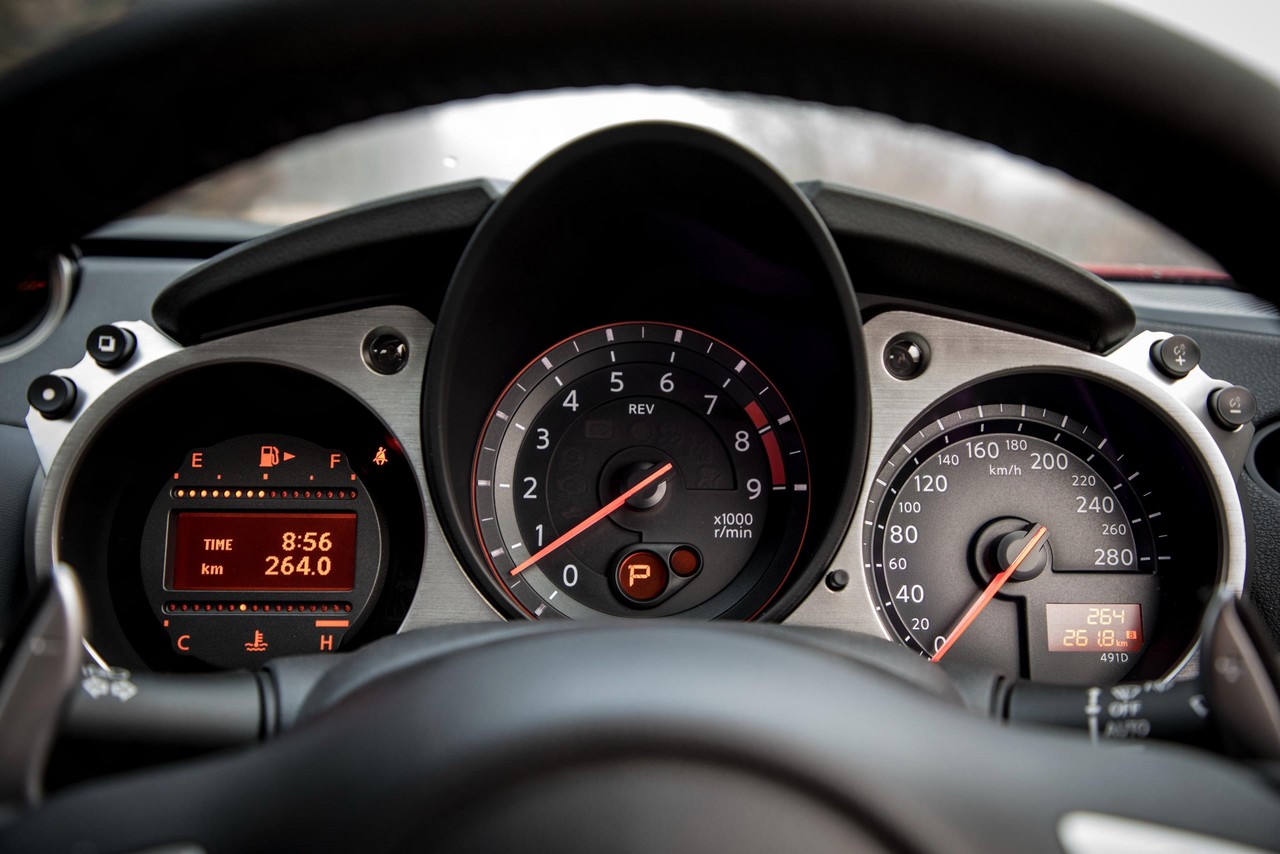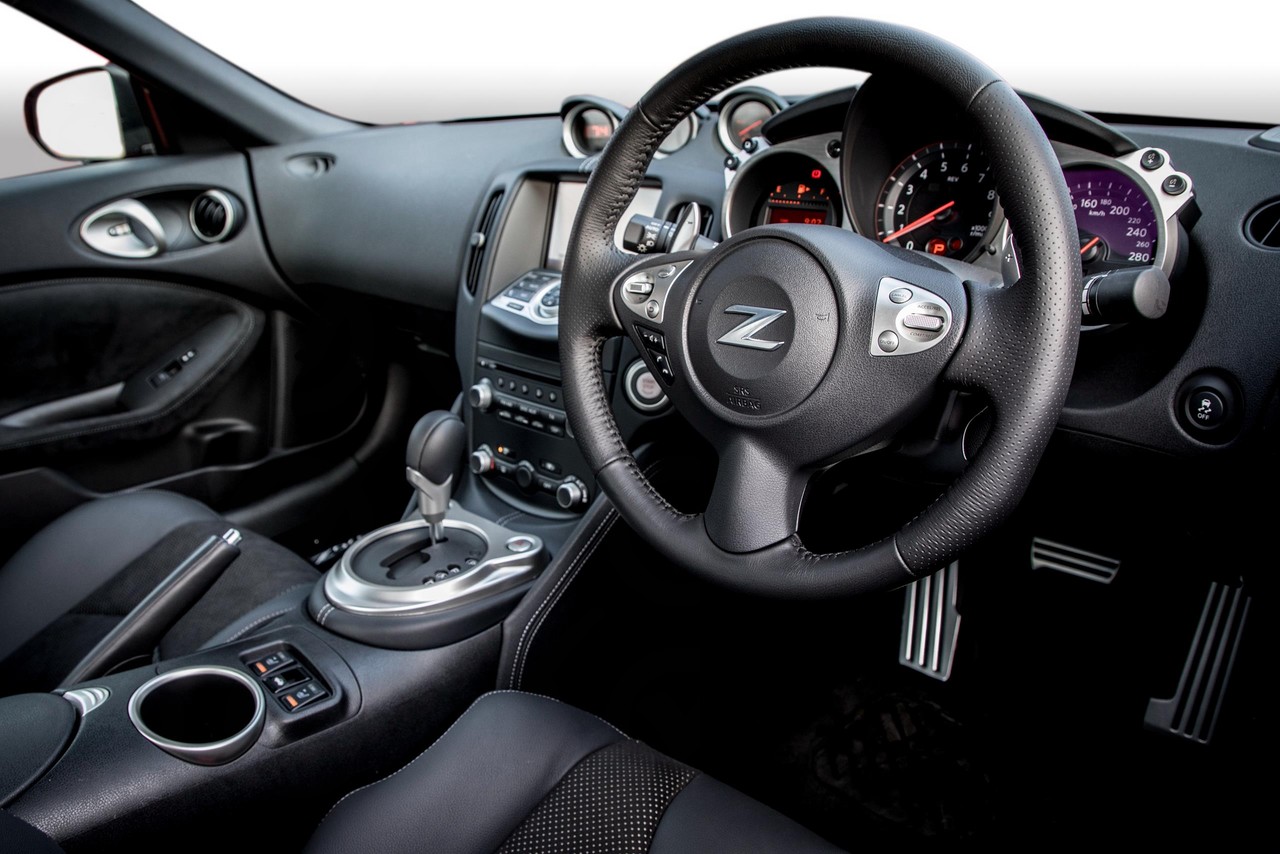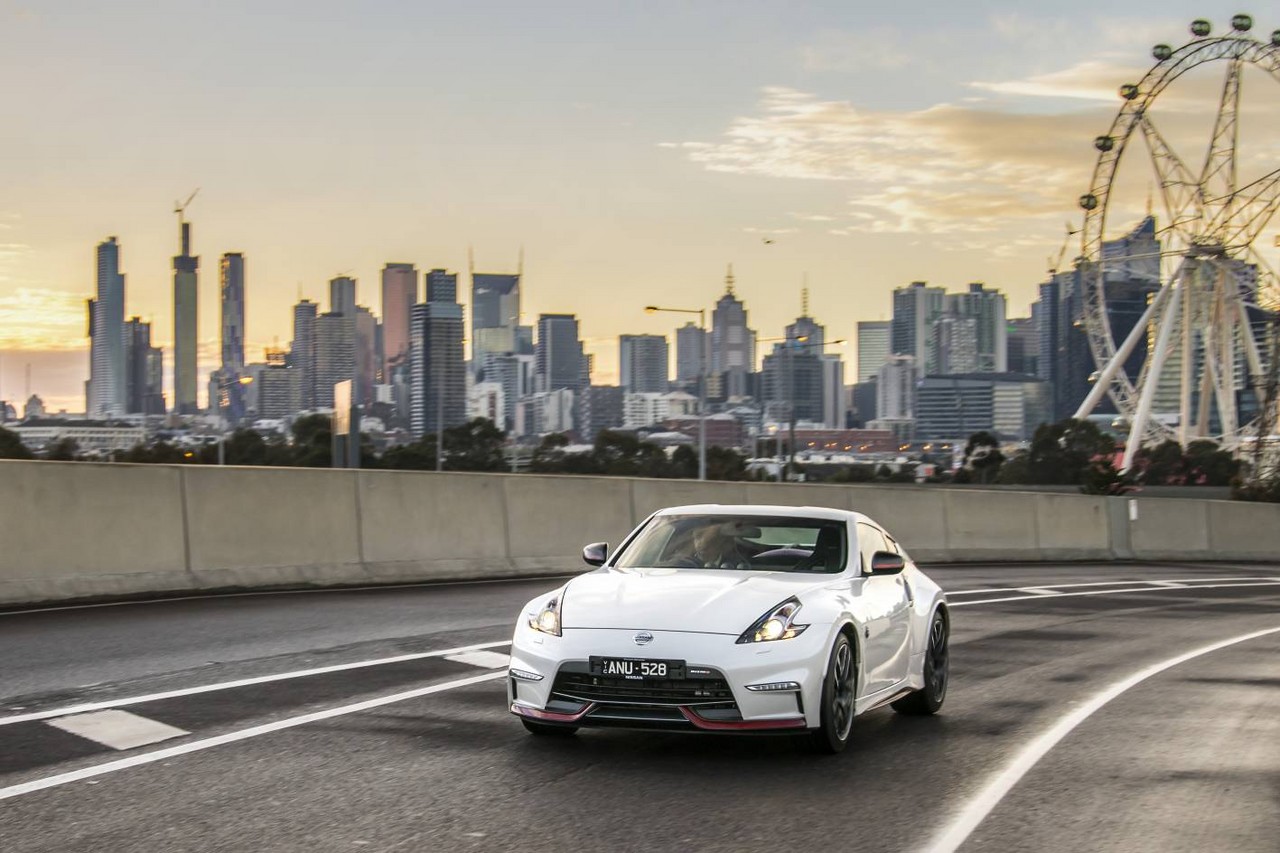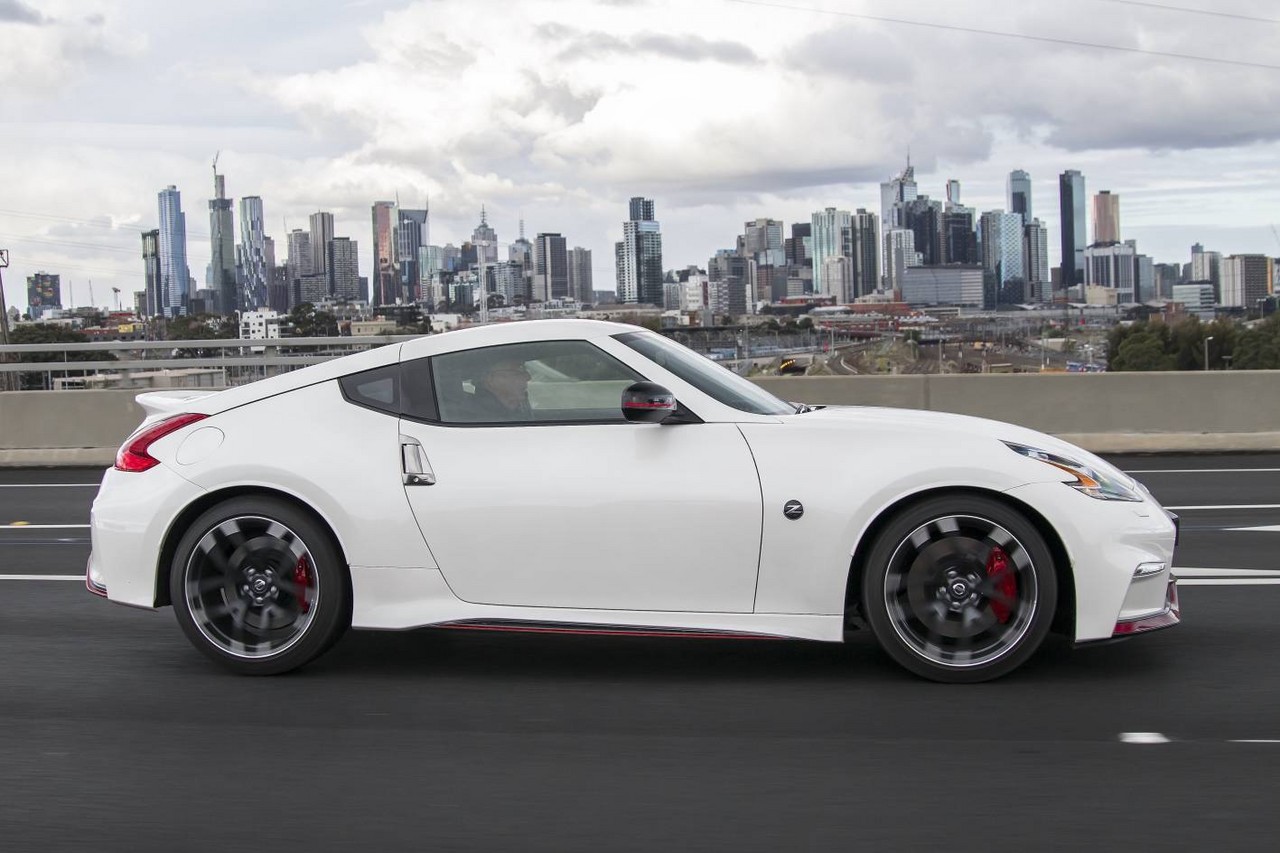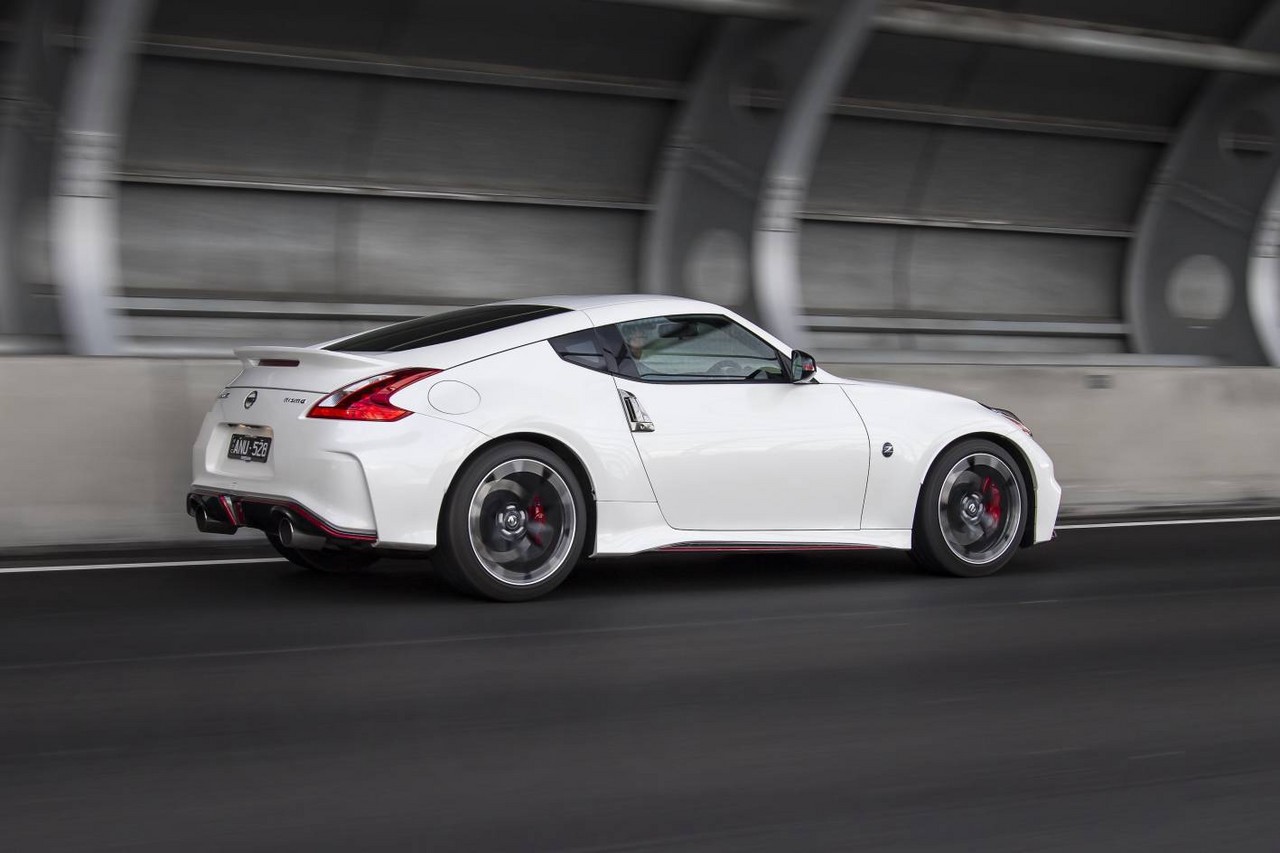
- Powerful 3.7-litre VQ37VHR V6 engine
- Refined six-speed manual transmission
- Excellent dynamics
- Intuitive automatic transmission
- Suspension lacks low-speed compliance
- Engine vibration at high rpm
- Interventionist electronic stability control system
- Poor rear visibility
- Cheap interior plastics
- Tyre noise
Review: Nissan Z34.I 370Z (2009-12)
Overview
Released in May 2009, the Nissan Z34 Series I (Z34.I) 370Z was initially available as a coupe, with soft-top convertible (‘Roadster’) models following in February 2010. Manufactured in Tochigi, Japan, the rear-wheel drive 370Z was powered by a 3.7-litre V6 petrol engine (Nissan’s VQ37VHR) that was mated to either a six-speed manual or seven-speed automatic transmission.
Nissan 370Z: VQ37VHR engine
The Nissan 370Z’s 3696 cc VQ37VHR engine had an open-deck, aluminium block with a bedplate for the main bearing supports, four bolts per main bearing journal, a micro-polished forged crankshaft, an aluminium alloy cylinder head, chain-driven double overhead camshafts, four valves per cylinder actuated by diamond-like carbon (DLC) coated roller finger followers, sequential multi-port fuel injection, individual ignition coils mounted directly on the spark plug (the ‘Nissan Direct Ignition System’ or NDIS), a compression ratio of 11.0:1, twin knock sensors and a 7600 rpm redline.
For the VQ37VHR engine, the intake camshaft was variable over a range of 36 degrees (Nissan’s ‘Continuously Variable-valve Timing Control’, or CVTC). The VQ37VHR engine also featured Nissan’s ‘Variable Valve Event and Lift’ (VVEL) lift system which used a rocker arm, control cam (eccentric cam), two links (‘A’ and ‘B’), an output cam (oscillating cam), input cam (eccentric cam), control shaft and DC motor to provide variable intake valve timing and variable intake valve lift. Specifically, the movement of the output cam was varied by rotating the control shaft with a DC stepper motor and changing the fulcrums of the links – this provided continuous adjustment of valve lift. According to Nissan, VVEL provided:
- Low valve lift at low throttle openings to reduce pumping losses; and,
- Greater valve lift for increased throttle openings to improve cylinder filling
Although the VQ37VHR engine had dual drive-by-wire throttle bodies, the VVEL system could act sufficiently quickly that varying valve lift was the primary means of throttling the engine.
| Body | Years | Engine | Trans. | Peak power | Peak torque |
|---|---|---|---|---|---|
| 370Z Coupe | 2009-12 | 3.7-litre VQ37VHR petrol V6 | 6sp man., 7sp auto |
245 kW at 7000 rpm | 363 Nm at 5200 rpm |
| 370Z Roadster | 2010-12 |
Transmissions
The Nissan 370Z was available with either:
- Six-speed Aichi FS6R31 manual transmissions; or
- Seven-speed Jatco JR710E automatic transmissions.
The six-speed manual transmissions featured ‘SynchroRev Match’ control, which – when changing gears – calculated the target engine speed and automatically adjusted the electronic throttle accordingly.
Dimensions and body
Compared to the Nissan Z33 350Z , the Z34 370Z Coupe was 65 mm shorter (at 4250 mm), 30 mm wider (1845 mm), 5 mm lower (1315 mm) and had a 100 mm shorter wheelbase (2550 mm). Compared to the coupe, the 370Z convertible was 10 mm taller (at 1325 mm), though the other measurements were unchanged. The 370Z Coupe and Roadster had drag co-efficients of 0.31 Cd and 0.33 Cd, respectively.
For the coupe models, torsional rigidity increased by up to 30 per cent, most notably at the front of the vehicle where a bracing bar was mounted on top of the suspension turrets. The extensive use of aluminium in the doors, bonnet and tailgate (coupes only) also meant that the 370Z was slightly lighter than its predecessor.
Suspension
The Nissan 370Z had double wishbone front suspension and independent, multi-link rear suspension (both with coil springs, gas-filled dampers and anti-roll bars).
Safety equipment
Standard safety equipment for the Nissan 370Z included dual front airbags, front seat-mounted side airbags, curtain airbags (door-mounted for the convertible), ABS, electronic brake force distribution, brake assist, electronic stability control, traction control, active front seat head restraints and front seatbelts with pretensioners and load limiters; the Roadster was also fitted with rollover protection bars.
Brakes
The Nissan 370Z had 355 mm by 32 mm ventilated front disc brakes with four-piston calipers and 350 mm by 20 mm ventilated rear discs with twin-piston calipers.
Features: Nissan 370Z
Standard features for the Nissan 370Z included 18-inch alloy wheels (19-inch alloys for the Roadster), an eight speaker Bose sound system with six-stack CD player and auxiliary inputs, satellite navigation with seven-inch display, dual-zone climate control air conditioning, leather seats with heating, an eight-way power adjustable driver’s seat, a four-way power adjustable passenger seat, Bluetooth mobile phone integration, cruise control, a leather-wrapped steering wheel, rain-sensing wipers, automatic headlights, proximity key with keyless start, power windows and mirrors, a trip computer, 12 volt power outlets and an immobiliser.
For the Nissan 370Z Roadster, standard features were extended to include ‘climate controlled’ front seats with heating and cooling functions. Furthermore, the 370Z Roadster had a rear glass wind deflector and its power-operated roof could be lowered or raised in twenty seconds.
As standard, the 370Z was also fitted with a viscous limited slip rear differential.
April 2011: 370Z update
In April 2011, the Nissan 370Z coupe and convertible underwent a minor update, with both receiving an updated audio and navigation system with touch-screen display, USB and Bluetooth connectivity, 9.3 GB hard drive, reversing camera and wide-angle door mirrors. Coupe models were also fitted with a cargo blind, while the Roadster received climate controlled seats.
Brochures
Specifications
Related links
Review: Nissan Z34.II 370Z (2012-21)
Overview
Production of the Nissan Z34 Series II (Z34.II) 370Z commenced in July 2012. Visually, the Nissan Z34.II 370Z could be identified by its vertical LED daytime running lights and new front bumper.
The Nissan 370Z NISMO was released in Australia in September 2017. For the 370Z NISMO, its increased power and torque were achieved by an H-configured exhaust system and muffler tuning which reduced back pressure ‘by up to 30 per cent’ and a unique ECM (Engine Control Module) calibration.
| Body | Engine | Trans. | Peak power | Peak torque |
|---|---|---|---|---|
| 370Z Coupe | 3.7-litre VQ37VHR petrol V6 | 6sp man., 7sp auto |
245 kW at 7000 rpm | 363 Nm at 5200 rpm |
| 370Z Roadster | ||||
| 370Z Nismo | 3.7-litre VQ37VHR petrol V6 | 6sp man., 7sp auto |
253 kW at 7400 rpm | 371 Nm at 5200 rpm |
Safety equipment and features
Compared to its Z34.I predecessor, standard safety equipment and features for the Nissan Z34.II 370Z were unchanged.
July 2017 update (‘2018 model year’)
Production of the ‘2018 model year’ Nissan 370Z commenced in July 2017. Visually, the updated 370Z could be identified by its dark-tinted headlamps and rear combination lights, black door handles and black rear bumper fascia. For models with manual transmissions, however, a new high-performance EXEDY clutch was introduced to reduce pedal effort and provide greater ‘gear change precision and comfort’.
Nissan 370Z NISMO
The Nissan 370Z NISMO was released in Australia in August 2017. Visually, the 370Z NISMO could be identified by its aerodynamic enhancements for the front and rear fascia, side sills and rear spoiler. While the 370Z NISMO had the same drag co-efficient as the standard 370Z Coupe (0.31 Cd), Nissan claimed that the NISMO bodykit increased front and rear downforce.
The 370Z NISMO had specially tuned suspension with increased spring, dampening and stabiliser rates, and performance dampers (front and rear). The Nissan 370Z NISMO was fitted with 19 x 9.5J front and 19 x 10.5J rear forged alloy wheels that were produced by RAYS, and Dunlop SP Sport Maxx GT 600 high-performance tyres (245/40 R19 98W front and 285/35 R19 103W rear). The 370Z NISMO, however, omitted the temporary spare wheel of the standard 370Z and instead had a tyre repair kit.
The interior of the 370Z NISMO was distinguished by its Recaro front seats in black and red Alcantara with leather accents; the seats had eight-way manual adjustment for the driver’s seat and four-way adjustment for the front passenger’s, but omitted the active and adjustable headrests of the standard 370Z.
2018 Nissan 370Z N-Sport
Released in August 2018, Nissan claimed that the Nissan 370Z N-Sport was ‘based off’ the Datsun 280ZX Black Gold edition that was released in 1980. The Nissan 370Z N-Sport could be identified by its 18-inch alloy wheels, black gloss door mirror caps and exterior graphics which started at the tip of its bonnet and extended over the roof and bootlid, and across the front doors. Inside, the 370Z N-Sport had yellow accents on the door trim, steering wheel, gearshift knob, knee pads and dashboard, while the black cloth seats had yellow embroidery.
The Nissan 370Z N-Sport was available in three paint finishes – Chicane Yellow and ‘premium’ Diamond Black and Shiro White colours – and Australian deliveries were limited to fifty (50) vehicles. Recommended retail prices for the Nissan 370Z N-Sport started at $48,490 (plus on-road costs).
2019 Nissan 370Z 50th Anniversary Edition
The Nissan 370Z 50th Anniversary Edition was released in Australia in August 2019. Visually, the Nissan 370Z 50th Anniversary Edition could be identified by its red, white, silver and black colour scheme which was based on the #46 Brock Racing Enterprises (BRE) Datsun 240Z that won the 1970 and 1971 SCCA National Championships in the USA. Other additions included:
- 19-inch wheels with red rings; and,
- ’50th Anniversary’ badging on the front quarter panels and rear;
Inside, the Nissan 370Z 50th Anniversary Edition featured:
- Red leather seat mesh with a ’50th Anniversary’ wreath around the ‘Z’ logo;
- Red stitching for the doors, kneed pad, ‘C’ cluster and steering wheel (with red centre mark);
- Red highlights for the gear shift knob and shifter boot, plus a ’50th Anniversary’ logo;
- A ’50th Anniversary’ logo for the tachometer; and,
- A dark chrome ‘Z’ loo on the kick plates and a black finisher.
Brochures
Specifications
Related links
- Nissan Australia: Nissan 370Z Coupe
- Nissan Australia: Nissan 370Z Roadster
- Wikipedia.org: Nissan Z34 370Z
